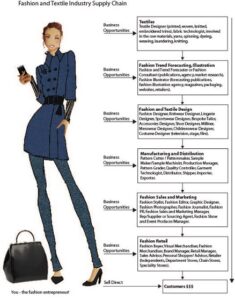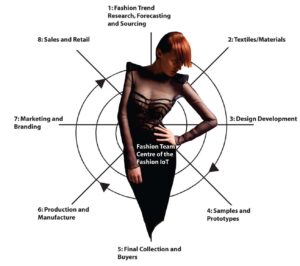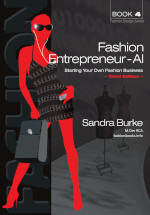Fashion Entrepreneur – AI (Artificial Intelligence) 3ed – Starting Your Own Fashion Business
Author: Sandra Burke
ISBN: print: 978-0-9941492-7-5 (2023)
ISBN: ebook: 978-0-9941492-8-2 (2023)
Price: £19.95, US$29.95, R350
Pages: 176
Size: A4(297x210x10mm)
Weight: 770g

Author: Sandra Burke
FASHION ENTREPRENEUR, now in its 3rd EDITION, is essential reading for those planning to set up and run a successful business within the fashion and creative industries.
This book guides the reader through the process of creating a fashion business (including online businesses); spotting and exploiting opportunities, networking to build a personal network of useful contacts, writing a business plan, branding and marketing, and managing a business on a day-to-day basis.
The theory is presented as a step-by-step guide, packed with case studies and interviews, inspiring fashion illustrations, diagrams and imagery from established fashion entrepreneurs to enhance the understanding of the subject area.
New Chapter – A special feature of this third edition is a new chapter on Fashion Artificial Intelligence, which shows how AI techniques are used to enhance the Fashion Design Process 4.0 and is structured around the Fashion Internet of Things (IoT). These innovative technologies (AI and IoT) are important aspects of the whole Fashion 4.0 process. This chapter presents:
- The logical subdivision of work from Trend Research and Analysis through to Online Shopping.
How the Internet of Things (IoT) connectivity gathers data from all fashion activities.
A comparison of the new AI techniques and systems with the Traditional way of working.
Sandra has peppered each section with her personal international experience of working in all areas of the fashion industry.
As we enter the early stages of the fourth industrial revolution (4IR), Artificial Intelligence (AI) and smart digital technology is adding another important capability to the Creative Industries including those in: Fashion and Textile Design, Manufacturing and Distribution, Sales, Marketing and Branding, and Fashion Retail.
Fashion schools were quick to incorporate 2D computing software such as Illustrator, Photoshop and Lectra into their syllabus, the challenge now is to embrace the latest cyber-physical machines (such as 3D printing) and AI techniques to enable students to lead the transformation with, for example, digital twin humans (avatars), intelligent marketing, customer-centric manufacturing, predictive analytics and virtual fitting rooms.
Fashion Entrepreneur – AI 3ed includes the following chapters:
Chapter 1: Fashion Entrepreneurs’ Runway to Success – introduces the basic definitions that underpin entrepreneurship and introduces the topics discussed in this book.
Chapter 2: Opportunities in the Fashion and Creative Industries – uses the fashion and textiles industry supply chain to subdivide the industry into its component parts and identify these business opportunities.

Figure 2.1 Fashion and Textile Industry Supply Chain (Value Chain) – shows the vertical integration of the key links in the supply chain from textiles to retail (sales to the customer). At each point on the supply chain there are potential business opportunities for the fashion entrepreneur.
Chapter 3: Fashion Entrepreneurs’ Traits – outlines the traits you can use to spot innovative opportunities, ‘make them happen’ and take ‘calculated’ risks.
Chapter 4: Networking – explains how to identify and analyze your key stakeholders’ needs and expectations, together with the benefits of working within a fashion cluster and working with a mentor.
Chapter 5: Competitive Advantage – outlines how you achieve competitive advantage, how you address barriers to entry, niche markets, outsourcing and the SWOT analysis.
Chapter 6: Business Plan – explains how to develop a business plan using seven key subheadings: Executive Summary, Product/Service Plan, Organization Plan, Sales and Marketing Plan, Production and Distribution Plan, Financial Plan, and Risk Management Plan.
Chapter 7: Starting Your Own Business – discusses the advantages and disadvantages of starting your own business and the steps you need to take to get started, including; company registration, intellectual property, budgets, setting up your premises, buying equipment, the design and production cycle, and the triggers that encourage you to start your own business.
Chapter 8: Market Research – discusses how to conduct market research to determine your target market and includes; trend research, competition and pricing strategy.
Chapter 9: Marketing and Branding – discusses how to develop and implement a marketing and branding strategy to advise your potential and existing customers of your products and ‘create an interest’.
Chapter 10: Sales and Negotiation – discusses the sales function: where to sell, how to present your products to the potential customer, and how to close the sale.
Chapter 11: Design and Production Cycle – outlines the key topics in this cycle; the design and production brief, the production plan, research and sourcing, design development, selling your collection, pre-production, production, distribution and shipping.
Chapter 12: Sources of Finance – demystifies the financial requirements you need to run your fashion business.
Chapter 13: Small Business Accounts – demystifies the various accounting terms and reports, and explains how to produce and manage; the cash book accounting method, the profit and loss statement, the cash flow statement, the breakeven analysis and the balance sheet.
Chapter 14: Project Management Skills – shows how to use specific project management techniques to plan and control your projects to be produced and delivered on time, within budget, and meet clients’ goals and objectives. It discusses small business growth phases and how to develop leadership and team building skills.
Chapter 15: Online Fashion Business and Social Media – explains the different levels of Internet use and collates the text bringing it to a cohesive presentation.
Chapter 16: Fashion Artificial Intelligence (AI) – presents the Fashion Internet of Things (IoT), showing how this innovative technique serves a number of purposes and the logical subdivision of work from Trend Analysis to Online Shopping. It explains how the IoT connectivity gathers data from all fashion activities and compares the new AI techniques and systems with the traditional way of working.

Figure 16.1: Fashion Artificial Intelligence Spiral and the Internet of Things (IoT) – shows how AI interlinks the Fashion and Textile Supply Chain’s key areas with smart technologies powering greater speed, lower costs and increased flexibility and agility at each stage.
Case Studies/Interviews: The text is supported with examples from various sectors of the fashion industry and case study interviews with fashion entrepreneurs who have developed their own successful fashion businesses.
Glossary, Index
This book guides the reader through the process of creating a fashion business (including online businesses); spotting and exploiting opportunities, networking to build a personal network of useful contacts, writing a business plan, branding and marketing, and how to manage a business on a day-to-day basis.

